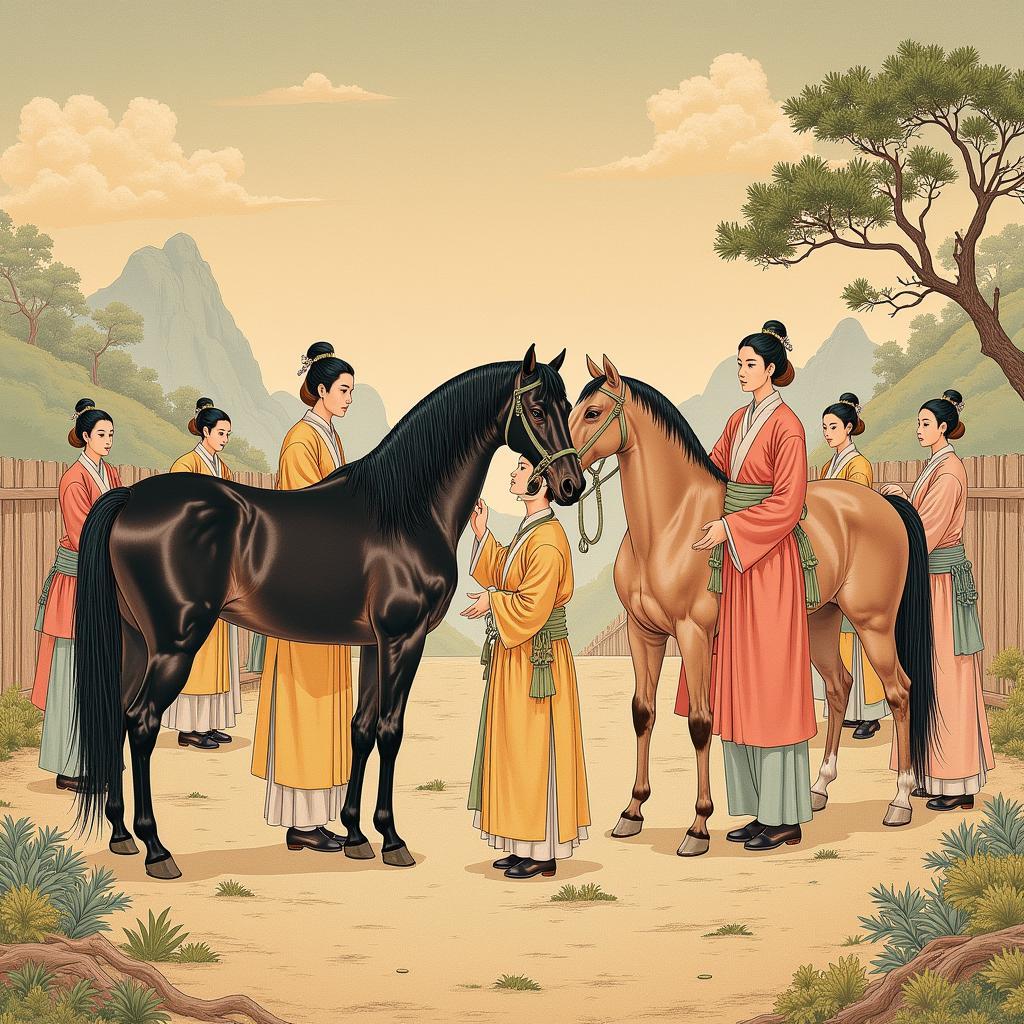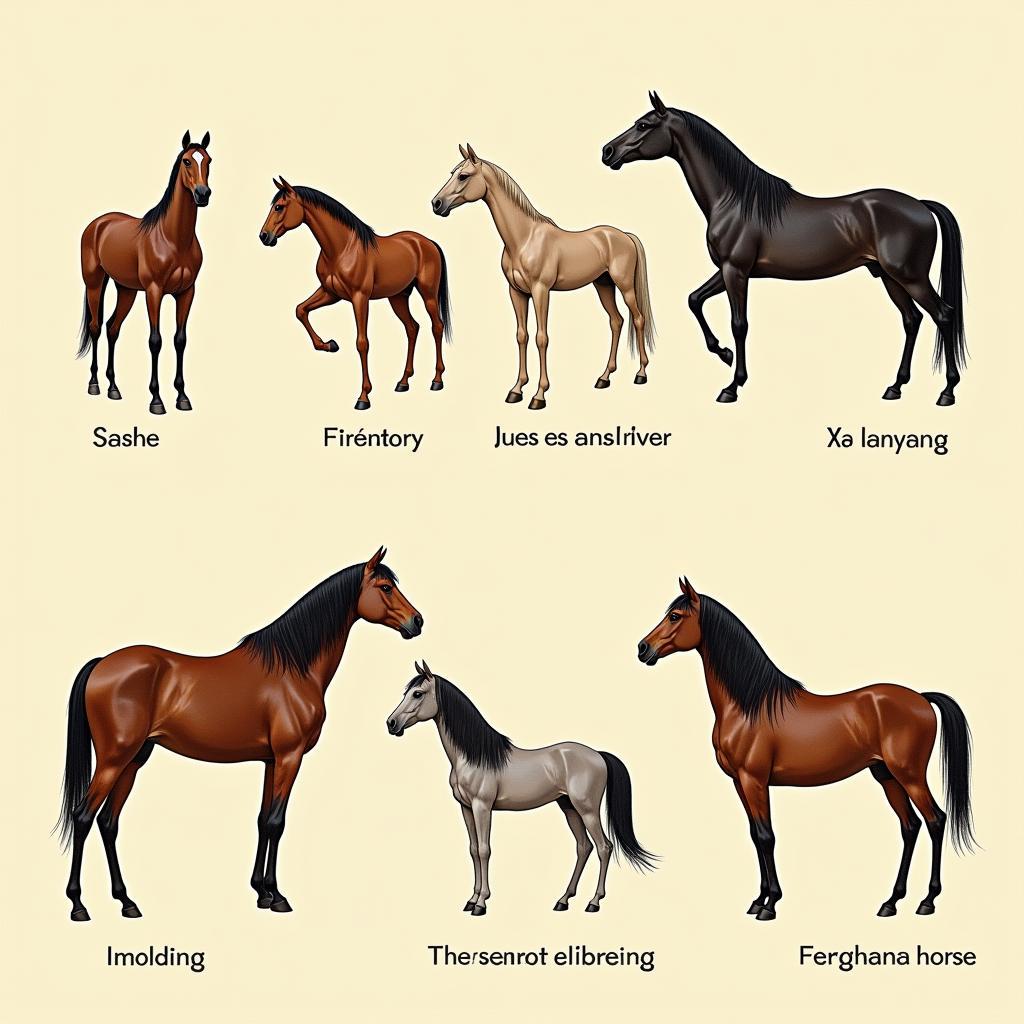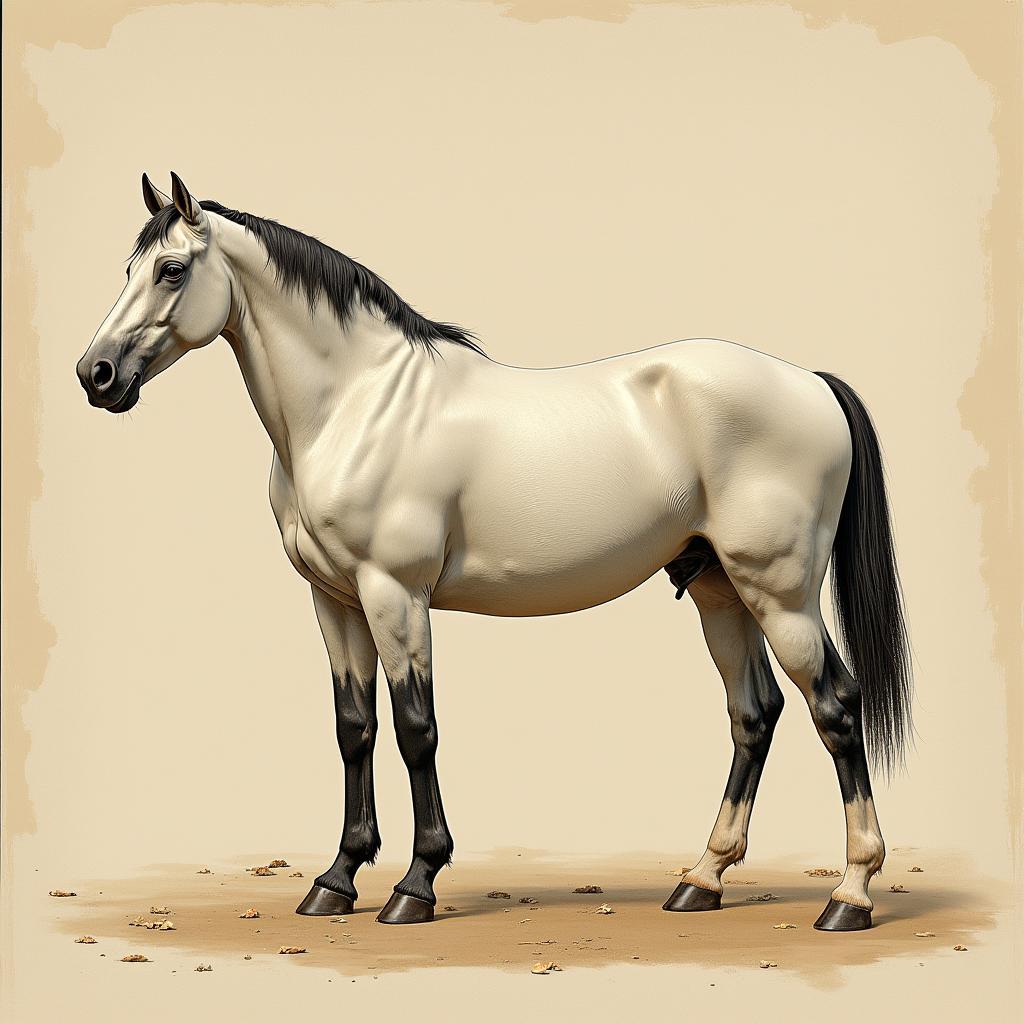Tang Dynasty Horse Reproduction played a vital role in the empire’s military might and economic prosperity. Horses were not only essential for warfare and transportation, but also held significant cultural and artistic value. Understanding the breeding practices of this era offers a fascinating glimpse into the sophisticated knowledge and appreciation of horses in ancient China.
Horses played a crucial role in the Tang Dynasty, influencing everything from military strength to artistic expression. Breeding practices were sophisticated, reflecting a deep understanding of equine genetics and husbandry. This article delves into the intricacies of Tang Dynasty horse reproduction, exploring the methods, the prized breeds, and the cultural significance of these magnificent animals. Let’s explore the world of Tang Dynasty horse reproduction and discover the fascinating details of this historical practice. We’ll cover everything from the specific breeds favored by the Tang emperors to the meticulous records they kept on their equine companions.
The Importance of Horses in Tang Dynasty China
The Tang Dynasty (618-907 AD) was a golden age for China, marked by significant advancements in art, culture, and military power. Central to this success were horses, which served as the backbone of the Tang army and facilitated trade along the Silk Road. The demand for strong, swift, and resilient horses drove the development of advanced breeding programs. The Tang Dynasty’s military prowess depended heavily on the quality of its cavalry, making Tang dynasty horse reproduction a national priority. Controlling the breeding process allowed the Tang to produce horses specifically suited for warfare.
The Tang Dynasty saw the importation of Ferghana horses, prized for their strength and endurance. These “celestial horses”, as they were known, became highly sought after, further fueling the focus on Tang dynasty horse reproduction. Owning a Ferghana horse became a status symbol, increasing demand and encouraging careful breeding practices. These horses were not only valued for their practical uses but also featured prominently in paint horse art, reflecting their cultural significance.
 Tang Dynasty Horse Breeding Scene
Tang Dynasty Horse Breeding Scene
Breeding Techniques and Management
Tang dynasty horse reproduction involved meticulous record-keeping and selective breeding. Detailed records of pedigrees, physical characteristics, and performance were maintained, allowing breeders to make informed decisions. Specific traits, such as speed, stamina, and temperament, were carefully selected and nurtured through generations. This systematic approach contributed to the development of distinct horse breeds, each tailored to specific roles within the empire. For instance, larger, more powerful horses were bred for warfare, while smaller, more agile horses were preferred for hunting and ceremonial purposes.
The Tang Dynasty’s understanding of equine health and nutrition was also advanced for its time. Horses received specialized diets and regular veterinary care, ensuring their well-being and reproductive success. This focus on health and nutrition contributed significantly to the success of Tang dynasty horse reproduction programs. Specialized treatises on horse care and breeding were written and circulated, demonstrating the importance placed on this practice.
Famous Tang Dynasty Horse Breeds
Several distinct horse breeds emerged during the Tang Dynasty, each with its unique characteristics. The Sanhe horse, known for its speed and endurance, was a favorite among the cavalry. Other notable breeds included the Xianyang horse, prized for its strength and suitability for carrying heavy loads, and the Ferghana horse, admired for its beauty and “blood-sweating” characteristic, believed to be a sign of exceptional strength. These horses became symbols of wealth and status, further elevating the importance of Tang dynasty horse reproduction. The meticulous breeding programs of the Tang Dynasty resulted in horses that were highly sought after throughout Asia.
 Different Tang Dynasty Horse Breeds
Different Tang Dynasty Horse Breeds
The Cultural Significance of Horses
Beyond their practical uses, horses held deep cultural significance in Tang Dynasty China. They were often depicted in art, literature, and ceramics, symbolizing power, prosperity, and good fortune. Horse figurines and statues, like the ones you can find on pages dedicated to a chinese horse statue, became popular burial goods, reflecting the belief that horses could carry the deceased to the afterlife. The importance of horses in Tang society further emphasized the significance of Tang dynasty horse reproduction, making it not only a practical necessity but also a cultural imperative. The Tang emperors were known for their love of horses and often commissioned elaborate artwork featuring their equine companions.
The Legacy of Tang Dynasty Horse Breeding
The Tang Dynasty’s advanced understanding of horse reproduction left a lasting impact on equine breeding practices in China and beyond. Their meticulous record-keeping and selective breeding techniques laid the foundation for the development of many modern horse breeds. The knowledge gained during this period continues to inform equine management and breeding practices today. The legacy of Tang dynasty horse reproduction serves as a testament to the enduring bond between humans and horses.
 Legacy of Tang Horse Breeding
Legacy of Tang Horse Breeding
Conclusion
Tang dynasty horse reproduction was a sophisticated and vital aspect of Tang society, contributing to the empire’s military strength, economic prosperity, and cultural richness. The meticulous breeding practices, coupled with a deep appreciation for the horse’s beauty and symbolic power, ensured that horses played a central role in Tang Dynasty China. Their legacy continues to influence horse breeding practices today, reminding us of the enduring importance of these magnificent animals throughout history. Understanding Tang dynasty horse reproduction provides valuable insights into the sophisticated knowledge and deep appreciation for horses in ancient China.
FAQ
- What were the most prized horse breeds in the Tang Dynasty? The Ferghana, Sanhe, and Xianyang horses were among the most highly valued breeds.
- Why was horse breeding so important in the Tang Dynasty? Horses were crucial for the military, trade, and held cultural significance.
- What were the key features of Tang Dynasty horse breeding practices? Meticulous record-keeping, selective breeding, and specialized care were key features.
- How did the Tang Dynasty’s approach to horse breeding influence later periods? Their techniques laid the foundation for modern horse breeding practices.
- What role did horses play in Tang Dynasty art and culture? Horses were frequently depicted in art and literature, symbolizing power and prosperity.
- How did the Tang Dynasty acquire Ferghana horses? These horses were imported from Central Asia, often through trade and diplomacy.
- What is the “blood-sweating” characteristic of Ferghana horses? This was likely caused by a parasitic skin infection, but was seen as a sign of strength.
Need further assistance with your equine needs? Contact us! Phone: 0772127271, Email: [email protected] Address: QGM2+WX2, Vị Trung, Vị Thuỷ, Hậu Giang, Vietnam. We have a 24/7 customer service team ready to assist.